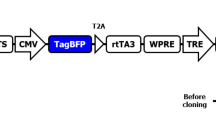Abstract
Double-stranded RNA-mediated interference (RNAi) has recently emerged as a powerful reverse genetic tool to silence gene expression in multiple organisms. RNAi based on DNA vector is not sufficiently established in chicken species. The present study was performed to evaluate RNAi induced by shRNA transcribed from mammalian Pol III promoter H1 in the chicken cells by using a dual fluorescence reporter assay, a plasmid encoding GFP and a plasmid encoding RFP. The evaluation of RNAi efficiency was performed in two kinds of chicken cell type: primary CEF cells and chicken DT-40 cells by lipofection. GFP- and RFP-expressing cells were observed under fluorescent microscopy, and their mRNAs content were analyzed by quantitative RT-PCR. The intensity of the green fluorescence generated by GFP was greatly suppressed by human H1 promoter transcribed GFP-shRNA. Quantitative RT-PCR analysis showed that normalized GFP mRNA expression was reduced to 37 and 32 in primary CEF and DT-40 cells, respectively. In contrast to GFP, the intensity of the red fluorescence generated by RFP protein and the RFP mRNA levels remained unchanged. Consequently, it was concluded that the RNAi induced by shRNA transcribed from mammalian Pol III promoter H1 is applicable to suppress the gene expression specifically and efficiently in chicken cells.
Similar content being viewed by others
Abbreviations
- CEF:
-
Chicken Embryonic Fibroblast
- DMEM:
-
Dulbecco’s modified Eeagle’s Medium
- EGFP:
-
enhanced Green Fluorescent Protein
- FBS:
-
fetal bovine serum
- Pol III:
-
RNA polymerase III
- RFP:
-
Red Florescent Protein
- RNAi:
-
RNA-mediated interference
- shRNA:
-
small hairpin RNA
- siRNA:
-
small interfering RNA
- Ts:
-
thymidines
References
M Okabe M Ikawa K Kominami T Nakanishi Y Nishimune (1997) FEBS. Lett. 407 313–319 Occurrence Handle10.1016/S0014-5793(97)00313-X Occurrence Handle9175875 Occurrence Handle1:CAS:528:DyaK2sXivFyrsrY%3D
ZY Gong BS Ju XK Wang JY He HY Wang PM Sudha T Yan (2002) Dev. Dyn. 223 204–215 Occurrence Handle10.1002/dvdy.10051 Occurrence Handle11836785 Occurrence Handle1:CAS:528:DC%2BD38XhsVGku7c%3D
CD Link (2001) Mech. Age. Dev. 122 1639–1649 Occurrence Handle10.1016/S0047-6374(01)00291-3 Occurrence Handle1:CAS:528:DC%2BD3MXlvFWlt7g%3D
WR Brown SJ Hubbard C Tickle SA Wilson (2003) Nature Rev. Genet. 4 87–98 Occurrence Handle1:CAS:528:DC%2BD3sXnsFaqsw%3D%3D
NJ Caplen (2002) Trends. Biotechnol. 20 49–51 Occurrence Handle10.1016/S0167-7799(01)01900-X Occurrence Handle11814589 Occurrence Handle1:CAS:528:DC%2BD38XovFahsA%3D%3D
GJ Hannon (2002) Nature 418 244–251 Occurrence Handle10.1038/418244a Occurrence Handle12110901 Occurrence Handle1:CAS:528:DC%2BD38XltFGmu7Y%3D
A Fire S Xu MK Montgomery SA Kostas SE Driver CC Mello (1998) Nature 391 806–811 Occurrence Handle10.1038/35888 Occurrence Handle9486653 Occurrence Handle1:CAS:528:DyaK1cXhtlCju74%3D
JR Kennerdell RW Carthew (1998) Cell 95 1017–1026 Occurrence Handle10.1016/S0092-8674(00)81725-0 Occurrence Handle9875855 Occurrence Handle1:CAS:528:DyaK1MXjslyktw%3D%3D
M Oelgeschlager J Larrain D Geissert RE De (2000) Nature 405 757–763 Occurrence Handle10866189 Occurrence Handle1:CAS:528:DC%2BD3cXksVOru7s%3D
P Svoboda P Stein H Hayashi RM Schultz (2000) Development 127 4147–56 Occurrence Handle10976047 Occurrence Handle1:CAS:528:DC%2BD3cXotVWisLY%3D
F Wianny M Zernicka-Goetz (2000) Nat. Cell. Biol. 2 70–75 Occurrence Handle10655585 Occurrence Handle1:CAS:528:DC%2BD3cXhtVyltL8%3D
V Pekarik D Bourikas N Miglino P Joset S Preiswerk ET Stoeckli (2003) Nat. Biotech. 21 93–96 Occurrence Handle10.1038/nbt770 Occurrence Handle1:CAS:528:DC%2BD3sXhvV2h
CE Krull (2004) Dev. Dyn. 229 433–439 Occurrence Handle10.1002/dvdy.10473 Occurrence Handle14991698 Occurrence Handle1:CAS:528:DC%2BD2cXislKrsL4%3D
WY Hu CP Myers JM Kilzer SL Pfaff FD Bushman (2002) Curr. Biol. 12 1301–1311 Occurrence Handle10.1016/S0960-9822(02)00975-2 Occurrence Handle12176358 Occurrence Handle1:CAS:528:DC%2BD38XmtlKgsrw%3D
GC Sui C Soohoo EB Affar F Gay YJ Shi WC Forrest Y Shi (2002) Proc. Nat. Acad. Sci. USA 99 5515–5520 Occurrence Handle10.1073/pnas.082117599 Occurrence Handle11960009 Occurrence Handle1:CAS:528:DC%2BD38XjtFKltrg%3D
TR Brummelkamp R Bernards R Agami (2002) Science 296 550–553 Occurrence Handle10.1126/science.1068999 Occurrence Handle11910072 Occurrence Handle1:CAS:528:DC%2BD38XjtFCjtrk%3D
H Repp H Draheim J Ruland G Seidel J Beise P Presek F Dreyer (1993) Proc. Nat. Acad. Sci. USA 90 3403–3407 Occurrence Handle7682700 Occurrence Handle1:CAS:528:DyaK3sXisFWksbc%3D
S Kojima D Wignjevic GG Borisy (2004) BioTechniques 36 74–79 Occurrence Handle14740488 Occurrence Handle1:CAS:528:DC%2BD2cXlvV2qtg%3D%3D
DM Gou T Narasaraju NR Chintagari NL Jin PC Wang L Liu (2004) Nucleic Acids Res. 32 e134 Occurrence Handle10.1093/nar/gnh129 Occurrence Handle15452203 Occurrence Handle1:CAS:528:DC%2BD2cXotlWlsr0%3D
C Chesnutt L Niswander (2004) Genesis 39 73–78 Occurrence Handle10.1002/gene.20028 Occurrence Handle15170691 Occurrence Handle1:CAS:528:DC%2BD2cXmsVyrtr0%3D
Author information
Authors and Affiliations
Corresponding author
Additional information
Jing Yuan and Xiaobo Wang - These authors contributed equally to this work.
Rights and permissions
About this article
Cite this article
Yuan, J., Wang, X., Zhang, Y. et al. Mammalian Pol III Promoter H1 can Transcribe shRNA Inducing RNAi in Chicken Cells. Mol Biol Rep 33, 33–41 (2006). https://doi.org/10.1007/s11033-006-0002-y
Accepted:
Issue Date:
DOI: https://doi.org/10.1007/s11033-006-0002-y




